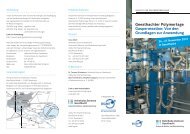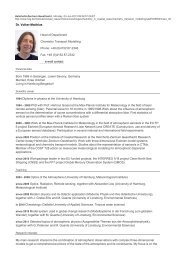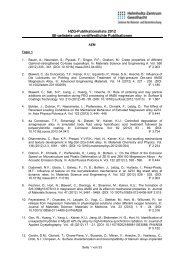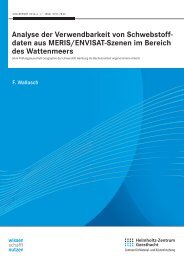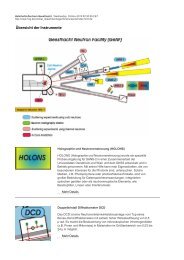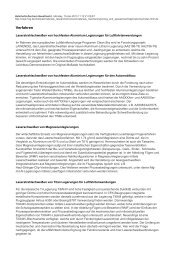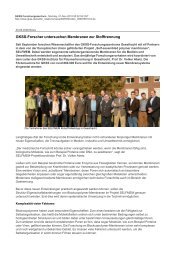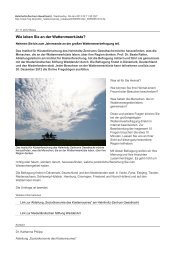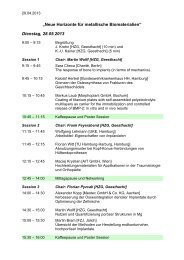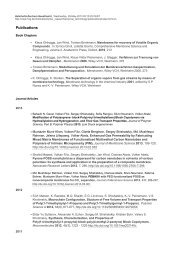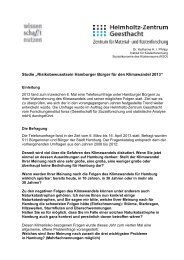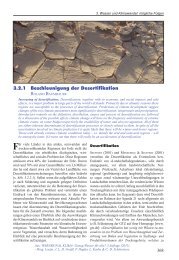Landfills and waste water treatment plants as sources of ... - GKSS
Landfills and waste water treatment plants as sources of ... - GKSS
Landfills and waste water treatment plants as sources of ... - GKSS
You also want an ePaper? Increase the reach of your titles
YUMPU automatically turns print PDFs into web optimized ePapers that Google loves.
METHOD OPTIMISATION<br />
3.3 Results<br />
3.3.1 Determination <strong>of</strong> m<strong>as</strong>s-to-charge ratio <strong>of</strong> PBDEs <strong>and</strong> musk fragrances<br />
Table 10: M<strong>as</strong>s-to-charge-ratio (m/z) <strong>of</strong> PBDEs <strong>and</strong> musk fragrances determined with GC-MS<br />
in the EI <strong>and</strong> NCI mode, respectively. MW: molecular weight, TI: Target Ion, Q1: Qualifier 1,<br />
Q2: Qualifier 2.<br />
32<br />
EI mode NCI mode<br />
Analyte MW TI Q1 Q2 TI Q1 Q2<br />
13<br />
C HCB 291 290 255 - 290 256 -<br />
ADBI 244 229 244 173 - - -<br />
AHMI 244 229 244 187 - - -<br />
MX D15 294 294 248 - - - -<br />
HHCB 258 243 213 258 - - --<br />
ATII 258 215 173 258 - - -<br />
AHTN D13 271 246 261 - - - -<br />
MX 297 282 297 - - - -<br />
AHTN 258 243 258 159 - - -<br />
MK 294 279 294 128 - - -<br />
Fluoranthene D10 212 212 106 - 212 211 -<br />
BDE28 407 248 408 139 327 328 326<br />
MBDE28 419 260 418 150 339 337 338<br />
MBDE47 498 338 498 228 417 419 415<br />
BDE47 486 326 486 406 407 405 404<br />
BDE100 565 404 564 484 405 403 484<br />
MBDE99 577 416 576 496 417 415 496<br />
BDE99 565 404 564 484 405 403 484<br />
BDE154 644 484 644 404 564 562 563<br />
MBDE153 656 496 656 416 496 494 498<br />
BDE153 644 484 644 404 564 562 563<br />
MBDE183 734 574 734 414 574 576 572<br />
BDE183 722 562 724 484 564 562 484<br />
MBDE 209 972 - - - 495 497 -<br />
BDE209 960 - - - 487 489 485<br />
3.3.2 Optimisation <strong>of</strong> the GC oven program<br />
In order to <strong>as</strong>ses the selectivity <strong>of</strong> the chromatographic process, separation factor � for each<br />
analyte w<strong>as</strong> calculated using following equation: �= k2/k1, where<strong>as</strong> k1 <strong>and</strong> k2 are the retention<br />
times <strong>of</strong> two peaks succeeding one another. For example, in the c<strong>as</strong>e where �=1, the two<br />
compounds are not separated, where<strong>as</strong> �=1.10 means that compounds differ in 10 % <strong>of</strong><br />
relative retention time <strong>and</strong> are well separated. Table 11 displays � values <strong>of</strong> each analyte at<br />
the tested parameters from section 3.2.3. It should be noted that m<strong>as</strong>s-labelled PBDEs were<br />
observed at same retention times <strong>as</strong> their native substances <strong>and</strong> are therefore not discussed<br />
separately.



